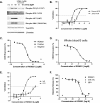Selective inhibition of spleen tyrosine kinase (SYK) with a novel orally bioavailable small molecule inhibitor, RO9021, impinges on various innate and adaptive immune responses: implications for SYK inhibitors in autoimmune disease therapy
- PMID: 24286216
- PMCID: PMC3978604
- DOI: 10.1186/ar4329
Selective inhibition of spleen tyrosine kinase (SYK) with a novel orally bioavailable small molecule inhibitor, RO9021, impinges on various innate and adaptive immune responses: implications for SYK inhibitors in autoimmune disease therapy
Abstract
Introduction: Spleen tyrosine kinase (SYK) is a key integrator of intracellular signals triggered by activated immunoreceptors, including Bcell receptors (BCR) and Fc receptors, which are important for the development and function of lymphoid cells. Given the clinical efficacy of Bcell depletion in the treatment of rheumatoid arthritis and multiple sclerosis, pharmacological modulation of Bcells using orally active small molecules that selectively target SYK presents an attractive alternative therapeutic strategy.
Methods: A SYK inhibitor was developed and assayed in various in vitro systems and in the mouse model of collagen-induced arthritis (mCIA).
Results: A novel ATP-competitive inhibitor of SYK, 6-[(1R,2S)-2-Amino-cyclohexylamino]-4-(5,6-dimethyl-pyridin-2-ylamino)-pyridazine-3-carboxylic acid amide, designated RO9021, with an adequate kinase selectivity profile and oral bioavailability, was developed. In addition to suppression of BCR signaling in human peripheral blood mononuclear cells (PBMC) and whole blood, FcγR signaling in human monocytes, and FcϵR signaling in human mast cells, RO9021 blocked osteoclastogenesis from mouse bone marrow macrophages in vitro. Interestingly, Toll-like Receptor (TLR) 9 signaling in human Bcells was inhibited by RO9021, resulting in decreased levels of plasmablasts, immunoglobulin (Ig) M and IgG upon B-cell differentiation. RO9021 also potently inhibited type I interferon production by human plasmacytoid dendritic cells (pDC) upon TLR9 activation. This effect is specific to TLR9 as RO9021 did not inhibit TLR4- or JAK-STAT-mediated signaling. Finally, oral administration of RO9021 inhibited arthritis progression in the mCIA model, with observable pharmacokinetics (PK)-pharmacodynamic (PD) correlation.
Conclusions: Inhibition of SYK kinase activity impinges on various innate and adaptive immune responses. RO9021 could serve as a starting point for the development of selective SYK inhibitors for the treatment of inflammation-related and autoimmune-related disorders.
Figures






References
-
- Fabian MA, Biggs WH 3rd, Treiber DK, Atteridge CE, Azimioara MD, Benedetti MG, Carter TA, Ciceri P, Edeen PT, Floyd M, Ford JM, Galvin M, Gerlach JL, Grotzfeld RM, Herrgard S, Insko DE, Insko MA, Lai AG, Lélias JM, Mehta SA, Milanov ZV, Velasco AM, Wodicka LM, Patel HK, Zarrinkar PP, Lockhart DJ. A small molecule-kinase interaction map for clinical kinase inhibitors. Nat Biotechnol. 2005;15:329–336. doi: 10.1038/nbt1068. - DOI - PubMed
MeSH terms
Substances
LinkOut - more resources
Full Text Sources
Other Literature Sources
Miscellaneous

